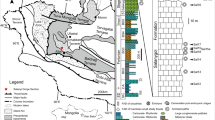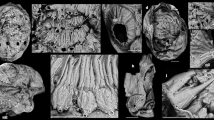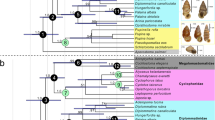Abstract
Comparative embryology is integral to uncovering the pattern and process of metazoan phylogeny1, but it relies on the assumption that life histories of living taxa are representative of their antecedents. Fossil embryos provide a crucial test of this assumption and, potentially, insight into the evolution of development, but because discoveries so far2,3,4,5 lack phylogenetic constraint, their significance is moot. Here we describe a collection of embryos from the Middle and Late Cambrian period (500 million years ago) of Hunan, south China, that preserves stages of development from cleavage to the pre-hatching embryo of a direct-developing animal comparable to living Scalidophora (phyla Priapulida, Kinorhyncha, Loricifera). The latest-stage embryos show affinity to the Lower Cambrian embryo Markuelia3, whose life-history strategy contrasts both with the primitive condition inferred for metazoan phyla and with many proposed hypotheses of affinity3,6, all of which prescribe indirect development. Phylogenetic tests based on these embryological data suggest a stem Scalidophora affinity. These discoveries corroborate, rather than contradict, the predictions of comparative embryology, providing direct historical support for the view that the life-history strategies of living taxa are representative of their stem lineages.
This is a preview of subscription content, access via your institution
Access options
Subscribe to this journal
Receive 51 print issues and online access
$199.00 per year
only $3.90 per issue
Buy this article
- Purchase on Springer Link
- Instant access to full article PDF
Prices may be subject to local taxes which are calculated during checkout



Similar content being viewed by others
References
Nielsen, C. Animal Evolution: Interrelationships of the Living Phyla 2nd edn (Oxford Univ. Press, Oxford, 2001)
Zhang, X.-G. & Pratt, B. R. Middle Cambrian arthropod embryos with blastomeres. Science 266, 637–639 (1994)
Bengtson, S. & Yue, Z. Fossilized metazoan embryos from the earliest Cambrian. Science 277, 1645–1648 (1997)
Kouchinsky, A., Bengtson, S. & Gershwin, L. Cnidarian-like embryos associated with the first shelly fossils in Siberia. Geology 27, 609–612 (1999)
Xiao, S., Zhang, Y. & Knoll, A. H. Three-dimensional preservation of algae and animal embryos in a Neoproterozoic phosphate. Nature 391, 553–558 (1998)
Conway Morris, S. Eggs and embryos from the Cambrian. Bioessays 20, 676–682 (1998)
Briggs, D. E. G., Kear, A. J., Martill, D. M. & Wilby, P. R. Phosphatization of soft-tissue in experiments and fossils. J. Geol. Soc. 150, 1035–1038 (1993)
Conway Morris, S. & Peel, J. S. Articulated halkieriids from the Lower Cambrian of north Greenland and their role in early protostome evolution. Phil. Trans. R. Soc. Lond. B 347, 305–358 (1995)
Conway Morris, S. The Middle Cambrian metazoan Wiwaxia corrugata (Matthew) from the Burgess Shale and Ogygopsis Shale, British Columbia, Canada. Phil. Trans. R. Soc. Lond. 307, 507–586 (1985)
Bohall, P. J., Wells, M. R. & Chandler, C. M. External morphology of larvae of Chordodes morgani (Nematomorpha). Invertebr. Biol. 116, 26–29 (1997)
Schmidt-Rhaesa, A. Phylogenetic relationships of the nematomorpha—a discussion of current hypotheses. Zool. Anz. 236, 203–216 (1998)
Wills, M. A. Cambrian and recent disparity: the picture from priapulids. Paleobiology 24, 177–199 (1998)
Schmidt-Rhaesa, A., Bartolomaeus, T., Lemburg, C., Ehlers, U. & Garey, J. R. The position of the Arthropoda in the phylogenetic system. J. Morphol. 238, 263–285 (1998)
Lemburg, C. Ultrastrukturelle Untersuchungen an den Larven von Halicryptus spinulosus und Priapulus caudatus—Hypothesen zur Phylogenie der Priapulida und deren Bedeutung für die Evolution der Nemathelminthes (Cuvillier, Göttingen, 1999)
Eriksson, B. J. & Budd, G. E. Onychophoran cephalic nerves and their bearing on our understanding of head segmentation and stem-group evolution of Arthropoda. Arthropod Struct. Dev. 29, 197–209 (2000)
Jenkins, R. J. F., Cooper, J. A. & Compston, W. Age and biostratigraphy of Early Cambrian tuffs from SE Australia and southern China. J. Geol. Soc. 159, 645–658 (2002)
Budd, G. E. & Jensen, S. in Telling the Evolutionary Time: Molecular Clocks and the Fossil Record (eds Donoghue, P. C. J. & Smith, M. P.) (CRC, London, 2003)
Crimes, T. P. Trace fossils and correlation of late Precambrian and early Cambrian strata. Geol. Mag. 124, 97–119 (1987)
Budd, G. E. & Jensen, S. A critical reappraisal of the fossil record of bilaterian phyla. Biol. Rev. 74, 253–295 (2000)
Nielsen, C. Animal Evolution: Interrelationships of the Living Phyla, 1st edn (Oxford Univ. Press, New York, 1995)
Val'kov, A. K. in Pozdnij Dokembrij i Rannij Paleozoj Sibiri, Vendskie Otlozheniya (eds Khomentovsky, V. V., Yakshin, M. S. & Karlova, G. A.) 37–48 (Inst. Geol. Geofiz. SO AN SSSR, Novosibirsk, 1983)
Acknowledgements
We thank W. Guo for field assistance, and S. Bengtson and S. Conway Morris for discussion. This work was supported by grants from the National Natural Science Foundation of China, Laboratory of Paleobiology and Stratigraphy of the Nanjing Institute of Geology & Paleontology, Chinese Academy of Sciences and the Ministry of Education of China (to X.-P.D.); the Royal Society and Natural Environment Research Council (to P.C.J.D.); and the Ministry of Science and Technology of China (to J.-B.L.).
Author information
Authors and Affiliations
Corresponding authors
Ethics declarations
Competing interests
The authors declare that they have no competing financial interests.
Supplementary information
41586_2004_BFnature02215_MOESM1_ESM.rtf
Supplementary Information: This details the cladistic analysis underlying the results presented in Dong et al. It includes a datamatrix, datasources, character descriptions, justification of coding strategies and experimental procedures employed, description of component and statistical analyses, and a comparison to existing morphology, molecular and total evidence analyses of ecdysozoan interrelationships. (RTF 2400 kb)
Rights and permissions
About this article
Cite this article
Dong, Xp., Donoghue, P., Cheng, H. et al. Fossil embryos from the Middle and Late Cambrian period of Hunan, south China. Nature 427, 237–240 (2004). https://doi.org/10.1038/nature02215
Received:
Accepted:
Issue Date:
DOI: https://doi.org/10.1038/nature02215
This article is cited by
-
Tube-dwelling in early animals exemplified by Cambrian scalidophoran worms
BMC Biology (2021)
-
Exceptionally preserved early Cambrian bilaterian developmental stages from Mongolia
Nature Communications (2021)
-
Exceptionally preserved Cambrian loriciferans and the early animal invasion of the meiobenthos
Nature Ecology & Evolution (2017)
-
Applications of scanning electron microscopy in earth sciences
Science China Earth Sciences (2015)
-
Quadrapyrgites from the lower Cambrian of South China: growth pattern, post-embryonic development, and affinity
Chinese Science Bulletin (2014)
Comments
By submitting a comment you agree to abide by our Terms and Community Guidelines. If you find something abusive or that does not comply with our terms or guidelines please flag it as inappropriate.



